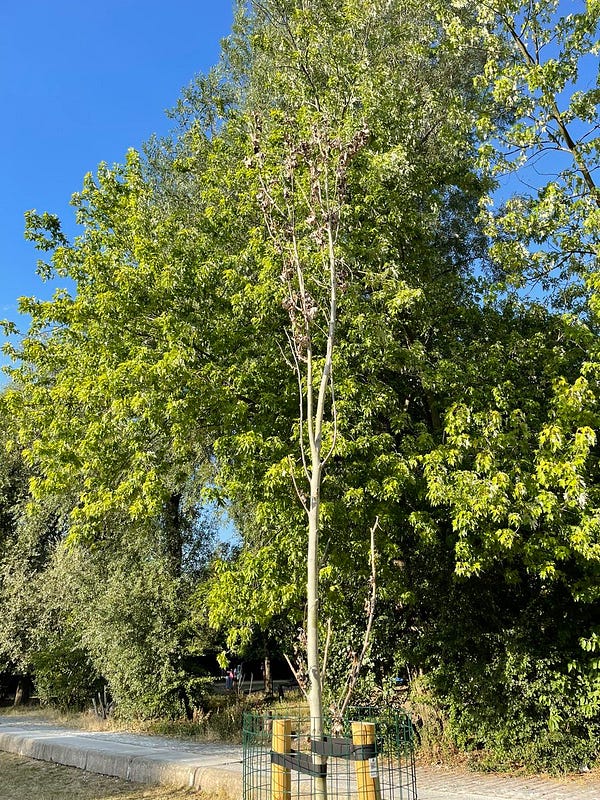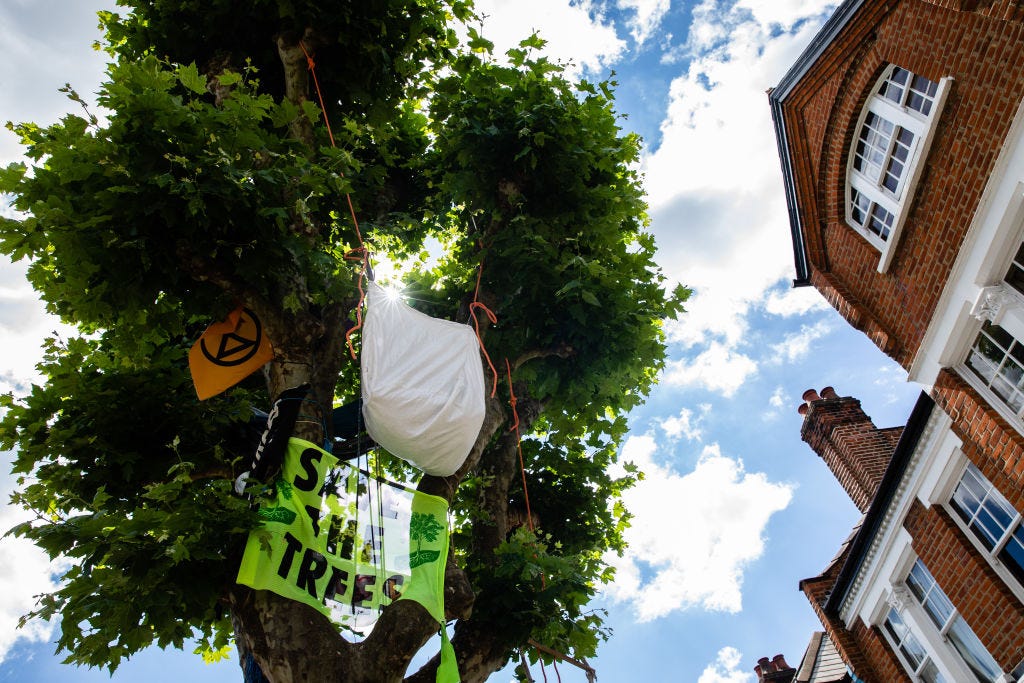Tales from the Urban Forest: You can't grow concrete
How an occupied plane tree in Haringey highlights our changing attitude to urban trees
Tales from the Urban Forest is a new quarterly column by the writer Paul Wood focusing on London’s flora, fauna and its landscapes.
It deals with the city’s unregarded landmarks, the wild inhabitants who may have occupied the city for hundreds of years, the people, policies and ideas that have influenced the environment, and the precarious entanglement of humans and nature in this ever evolving city.
Paul is the author of several books about trees in London including London is a Forest, a second edition of which has just been published. He is the editor of the Great Trees of London Map published by Blue Crow Media, which we featured in the newsletter a few weeks ago.
On the face of it, the quiet, leafy streets of Stroud Green are an unlikely focus for environmental protests, but on Oakfield Road a 120-year-old London plane tree has been adorned with banners, a 24 hour vigil is kept beneath it, and people are occupying its canopy.
The tree has been earmarked for removal, and locals are not happy about it. So much so that they have formed the Haringey Tree Protectors, an increasingly well-organised group who are growing in confidence as more and more people become aware of their campaign. When I sat with them under the tree for 30 minutes recently, half a dozen protectors checked in, several passing motorists beeped approvingly, and two new volunteers were recruited.
The Oakfield Road tree has been condemned because insurers say it is the cause of subsidence affecting a nearby house. They have not made public their specific reasons why this tree should go, but from previous cases, it is likely they’re claiming the tree’s adventurous roots have undermined the house’s foundations or they have been soaking up more than their fair share of moisture causing the clay soil to contract.
The insurers are unwilling to carry out the necessary underpinning to right the house without the offending tree being removed, apparently to stop the same thing happening again.
Insurers routinely demand trees are removed, often without solid evidence that they are causing subsidence. According to the Tree Protectors, Haringey Council has not commissioned an investigation to independently verify if the Oakfield Road tree is the problem in this case. And even if it were, they argue that the tree could coexist with a properly underpinned house for years to come.
But the Oakfield Road Tree is just the tip of the iceberg. Right now there are 200 trees throughout the borough at risk of being lost to subsidence claims.
The council, it seems, is unwilling to risk a costly battle with insurers to protect public trees despite subjecting them to an expensive regime of frequent pollarding. Pollarding is the practice of removing higher branches resulting in tree growth being arrested to maintain the same shape and size year after year. This in turn means trees’ reliance on groundwater is also consistent – an argument councils can use when a tree is an accessory in a subsidence case.
Many would argue that the insurers and the council are out of step with the public. Trees, precisely because of their permanent presence and their longer-than-human life cycles, have increasingly become the focus of conflict. As predominantly nineteenth century British cities have aged, trees planted a hundred or more years ago have become ever more prominent, and as citizens increasingly understand the benefits trees offer we have become more alarmed at their removal.
On the one hand, government, corporations and the media tell us how important the environment is while their actions do not appear to support these sentiments. Maintaining trees can be a low priority for cash-strapped councils who have myriad social problems to deal with, and it should come as no surprise that corporations say one thing while doing another:



But are the epic tree protests in Sheffield, the ultimately ill-fated campaign to save the Happy Man Tree in Hackney and the stand by Oakfield Road’s Tree Protectors heralding a new militancy?
In Sheffield, the city council awarded a contract to maintain its trees to a company who saw an opportunity to reduce their costs by replacing old, expensive-to-manage trees with new, small trees. It soon became clear the idea was to replace about half the city’s street trees, and as the felling began, the potential tree loss was laid bare. Environmental and aesthetic benefits accrued over decades would be chipped overnight. Urban trees tend, unsurprisingly, to be concentrated in more affluent areas, and in Sheffield this was where the protests were focussed, enabling old school politicians to dismiss them as nimbyism.
This characterisation of public shock at environmental catastrophe as middle class busy-bodying is easy to do, but it ignores deeply felt eco anxiety, and trivialising the impulse to conserve trees by aligning it with hippie tree-hugging misrepresents who the motivated people are. Fighting to save a tree in N4 is a tiny step in the fight to avoid catastrophic sea-level rise in Vanuatu, but these issues are linked in the motivations of tree protectors, not all of whom are white, middle-aged or home-owners, and in Oakfield Road the local has become global.
Politicians are waking up to the climate crisis, and we’re planting more trees than ever. Tree planting is an important way to mitigate the effects of climate change and to improve urban air quality, but it is in danger of becoming a numbers game. We are told of thousands of trees being planted and of the millions being poured into it. Even the Daily Mail is happy to report when politicians make well-meaning announcements. Spending big to put new trees in the ground is headline grabbing stuff but it misses out on the long, slow part.
As a tree planting exercise on Hackney Marshes showed in 2020, a lot of trees died within months of their planting. Even if just 25% were lost (as opposed to the 70% some claim), this is a significant figure. Ensuring newly planted trees survive their first few years is crucial to their establishment and requires intervention through frequent watering, something that councils contract specialist businesses to do. But bureaucratic contractor schedules do not necessarily take into account the actual weather, and in a heatwave-prone city, this leads to lots of new trees not surviving their first few summers. In Southwark for instance, Twitter users have been reporting dozens of dead trees and it’s a pattern that’s being repeated across London:





Of course, if one tree dies, we can replant it. But we can’t keep replacing trees just to make the planting numbers stack up. Every replacement means another year or two is lost before we start seeing any benefits. Saplings offer little in the way of shade, pollution removal or carbon sequestration which all this tree planting is supposed to provide. For that to happen we need big trees like the Oakfield Road planes which take more than a human lifespan to reach maturity.
A ruse the Tree Protectors highlight is in the detail of tree replacement. If a mature tree has to go, they are nearly always replaced – after all, a vacant tree pit represents an opportunity to get those numbers up. But not all trees are equal. Different species have different characteristics, and so replacing a 120 year old London plane with an ornamental cherry is not equivalent to replacing it with another plane tree. Ornamental cherries, lovely as they are, might live for 40 years and will only ever be a fraction of the size of a London plane, therefore the benefits they offer are less, but cherries are cheaper to maintain and they don’t need to be pollarded every few years.
We need to acknowledge that we aren’t going to reap the benefits of trees planted today for years or even decades until they become large and mature, so we should value those we have and ensure new trees survive. We should also factor in the resources expended just to get them in the ground. In our globalised world, a London street tree might start life in Italy before being shipped to a nursery miles from London. So with this carbon-heavy journey in mind, we need to be brave about the trees we plant. Let's not plant a small, short-lived cherry or a rowan if we can plant a big, long-lived plane, lime or oak. We should acknowledge that if we want a mature urban forest in the future, we will need to nurture it for generations to come.
A useful framework called the Capital Asset Valuation of Amenity Trees, (or CAVAT, for short) has been developed to calculate the environmental value that any given tree provides, ‘ecosystem services’ in the jargon, which in turn equates to a financial value. This is useful in communicating how much older, larger trees contribute and how much it would cost to replace that contribution. But these quantifiable values offer little security to trees in the ground, so is it time to provide greater protection for urban trees?
Perhaps we should think about urban trees as we do buildings, with the best being listed. At present, trees can be the subject of Tree Preservation Orders granted by the council, but this legal protection is generally applied only to privately owned trees. Councils rarely, if ever, apply TPOs to trees managed by themselves. This means that important trees like the Happy Man Tree can be cut down. Legal protection of trees should be awarded by an independent body, as English Heritage awards listed status to buildings. In a scenario where the Oakfield Road tree was ‘listed’ the penalty for removing it would be so significant that the council and insurer would be compelled to rethink how they deal with subsidence cases.
There’s a lot at stake in N4. It will certainly be the campaign that continues to make people aware of the ease with which trees can be lost and it will no doubt recruit more people to the cause. Could it be a first step to a change in the law, the beginning of calls to offer greater statutory protection. Time will tell, but we must hope that the Oakfield Road Tree will last at least another 120 years, and will eventually enjoy the same protections and veneration as the Edwardian buildings it enhances.
You can follow Paul on social media @thestreettree.
Buy a copy of Paul’s book, London is a Forest.
And you can pick up the Great Trees of London map here.





